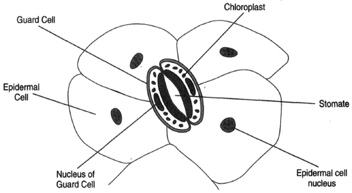Transpiration
Leaves are involved in three distinct plant functions: photosynthesis, respiration, and transpiration. While transpiration occurs primarily through leaves, some water is also lost by young stems. Is there any value to water loss? Banspiration has a cooling effect, but the benefits of this are unclear. Banspiration also aids the upflow of water from the roots, and, thereby, the delivery of dissolved minerals and water to the cells of the plant. In this sense, then, the plant is well served by transpiration. Yet, transpiration, especially in the extreme, can prove hazardous to the plant If not replaced by soil moisture, excessive water loss can result in the death of the plant.Magnitude of water loss is often striking. A single plant of corn, for example, can transpire fifty gallons of water during one season. A date palm growing in an oasis can transpire 35,000 gallons in a year!
 |
| Figure 34-3 A stomate in leaf epidermis. |
Stomates and Guard Cells
Higher plants fortunately have evolved a mechanism whereby excessive water loss is deterred. The major portion of transpiration takes place through openings in the leaves, called stomates (figure 34-3). The stomates are bounded by guard cells. The guard cells are able to respond to changing conditions, thereby closing the stomate when water loss threatens to be excessive and opening the stomate when transpiration is no longer a threat.
Although there are numerous exceptions, stomates are usually concentrated on the lower surfaces of leaves. The water lily, having its leaves floating on the surface of a pond, has stomates entirely on the upper surface. Stomates are usually very numerous, there being hundreds per square millimeter of leaf surface, and millions on an entire leaf. Table 34-1 shows the number of stomates per square millimeter of leaf surface for several species.
| Species | Upper Surface |
Lower Surface |
|---|---|---|
| Abies balsamea (balsam fir) | 0 | 228 |
| Lilium bulbifera (lily) | 0 | 62 |
| Mows alba (white mulberry) | 0 | 480 |
| Syringa vulgaris (lilac) | 0 | 330 |
| Nymphaea alba (water lily) | 460 | 0 |
| Pinus strobus (white pine) | 142 | 0 |
| Helianthus annuus (sunflower | 175 | 325 |
| Lycopersicon esculentum (tomato) | 12 | 130 |
| Phaseolus vulgaris (bean | 40 | 281 |
| Triticum sativum (wheat) | 33 | 14 |
The secondary wall thickenings of the guard cells are distributed in such a manner that when the cells lose turgor (that is, lose water), the guard cells change shape and close the stomates. When turgor is increased they again change shape to open the stomates. Although one might presume that the threat of water loss governs the closing of the stomates, this process may actually be governed by photosynthesis. The guard cells have chloroplasts, whereas other epidermal cells do not. When photosynthesis occurs in the guard cells, the concentration of carbon dioxide diminishes. Because carbon dioxide when dissolved in water creates an acidic condition, a decrease in carbon dioxide likewise decreases acidity. The solution thereby becomes more alkaline, a condition favorable to the breakdown of starch into sugars, and, thus, an increase of particles in the cytoplasm. This condition encourages the inflow of water to the guard cells, thus increasing their turgor, and causes them to change shape and open the stomates. While this explanation may not be entirely complete or correct, it is far from satisfactory to instead suggest that a stomate opens and closes simply because it needs to.




